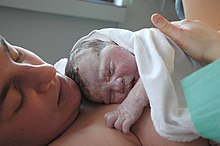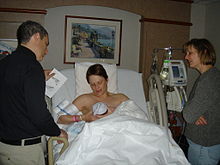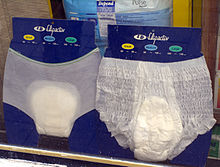
Midwifery is the health science and health profession that deals with pregnancy, childbirth, and the postpartum period, in addition to the sexual and reproductive health of women throughout their lives. In many countries, midwifery is a medical profession. A professional in midwifery is known as a midwife.

Childbirth, also known as labour, parturition and delivery, is the completion of pregnancy where one or more babies exits the internal environment of the mother via vaginal delivery or caesarean section. In 2019, there were about 140.11 million human births globally. In the developed countries, most deliveries occur in hospitals, while in the developing countries most are home births.

Postpartum depression has been known to be called many different names such as the following: Postpartum blues, baby blues, and maternity blues. This is all type of mood disorder experienced after childbirth, which can affect both sexes. Symptoms may include extreme sadness, low energy, anxiety, crying episodes, irritability, and changes in sleeping or eating patterns. PPD can also negatively affect the newborn child.

In human reproduction, a live birth occurs when a fetus exits the mother showing any definite sign of life such as voluntary movement, heartbeat, or pulsation of the umbilical cord, for however brief a time and regardless of whether the umbilical cord or placenta are intact. After the fetus is expelled from the maternal body it is called a neonate. Whether the birth is vaginal or by caesarean section, and whether the neonate is ultimately viable, is irrelevant.

Episiotomy, also known as perineotomy, is a surgical incision of the perineum and the posterior vaginal wall generally done by an obstetrician. This is usually performed during the second stage of labor to quickly enlarge the aperture, allowing the baby to pass through. The incision, which can be done from the posterior midline of the vulva straight toward the anus or at an angle to the right or left, is performed under local anesthetic, and is sutured after delivery.
Postpartum blues, also known as baby blues and maternity blues, is a very common but self-limited condition that begins shortly after childbirth and can present with a variety of symptoms such as mood swings, irritability, and tearfulness. Mothers may experience negative mood symptoms mixed with intense periods of joy. Up to 85% of new mothers are affected by postpartum blues, with symptoms starting within a few days after childbirth and lasting up to two weeks in duration. Treatment is supportive, including ensuring adequate sleep and emotional support. If symptoms are severe enough to affect daily functioning or last longer than two weeks, the individual should be evaluated for related postpartum psychiatric conditions, such as postpartum depression and postpartum anxiety. It is unclear whether the condition can be prevented, however education and reassurance are important to help alleviate patient distress.
Maternal health is the health of women during pregnancy, childbirth, and the postpartum period. In most cases, maternal health encompasses the health care dimensions of family planning, preconception, prenatal, and postnatal care in order to ensure a positive and fulfilling experience. In other cases, maternal health can reduce maternal morbidity and mortality. Maternal health revolves around the health and wellness of pregnant women, particularly when they are pregnant, at the time they give birth, and during child-raising. WHO has indicated that even though motherhood has been considered as a fulfilling natural experience that is emotional to the mother, a high percentage of women develop health problems and sometimes even die. Because of this, there is a need to invest in the health of women. The investment can be achieved in different ways, among the main ones being subsidizing the healthcare cost, education on maternal health, encouraging effective family planning, and ensuring progressive check up on the health of women with children. Maternal morbidity and mortality particularly affects women of color and women living in low and lower-middle income countries.
A postpartum disorder or puerperal disorder is a disease or condition which presents primarily during the days and weeks after childbirth called the postpartum period. The postpartum period can be divided into three distinct stages: the initial or acute phase, 6–12 hours after childbirth; subacute postpartum period, which lasts two to six weeks, and the delayed postpartum period, which can last up to six months. In the subacute postpartum period, 87% to 94% of women report at least one health problem. Long term health problems are reported by 31% of women.
Early postnatal hospital discharge generally refers to the postpartum hospital discharge of the mother and newborn within 48 hours. The duration of what is considered "early discharge" varies between countries from 12 to 72 hours due to the differences in average duration of hospital stay. The World Health Organization recommends healthy mothers and newborns following an uncomplicated vaginal delivery at a health facility to stay and receive care at the facility for at least 24 hours after delivery. This recommendation is based on findings which suggest that the first 24 hours after giving birth poses the greatest risks for both the mother and newborn.
Sex after pregnancy is often delayed for several weeks or months, and may be difficult and painful for women. Painful intercourse is the most common sexual activity-related complication after childbirth. Since there are no guidelines on resuming sexual intercourse after childbirth, the postpartum patients are generally advised to resume sex when they feel comfortable to do so. Injury to the perineum or surgical cuts (episiotomy) to the vagina during childbirth can cause sexual dysfunction. Sexual activity in the postpartum period other than sexual intercourse is possible sooner, but some women experience a prolonged loss of sexual desire after giving birth, which may be associated with postnatal depression. Common issues that may last more than a year after birth are greater desire by the man than the woman, and a worsening of the woman's body image.
Childbirth-related post-traumatic stress disorder is a psychological disorder that can develop in women who have recently given birth. This disorder can also affect men or partners who have observed a difficult birth. Its symptoms are not distinct from post-traumatic stress disorder (PTSD). It may also be called post-traumatic stress disorder following childbirth (PTSD-FC).
Antenatal depression, also known as prenatal or perinatal depression, is a form of clinical depression that can affect a woman during pregnancy, and can be a precursor to postpartum depression if not properly treated. It is estimated that 7% to 20% of pregnant women are affected by this condition. Any form of prenatal stress felt by the mother can have negative effects on various aspects of fetal development, which can cause harm to the mother and child. Even after birth, a child born from a depressed or stressed mother feels the affects. The child is less active and can also experience emotional distress. Antenatal depression can be caused by the stress and worry that pregnancy can bring, but at a more severe level. Other triggers include unplanned pregnancy, difficulty becoming pregnant, history of abuse, and economic or family situations.
HIV in pregnancy is the presence of an HIV/AIDS infection in a woman while she is pregnant. There is a risk of HIV transmission from mother to child in three primary situations: pregnancy, childbirth, and while breastfeeding. This topic is important because the risk of viral transmission can be significantly reduced with appropriate medical intervention, and without treatment HIV/AIDS can cause significant illness and death in both the mother and child. This is exemplified by data from The Centers for Disease Control (CDC): In the United States and Puerto Rico between the years of 2014–2017, where prenatal care is generally accessible, there were 10,257 infants in the United States and Puerto Rico who were exposed to a maternal HIV infection in utero who did not become infected and 244 exposed infants who did become infected.

Postpartum confinement is a traditional practice following childbirth. Those who follow these customs typically begin immediately after the birth, and the seclusion or special treatment lasts for a culturally variable length: typically for one month or 30 days, 26 days, up to 40 days, two months, or 100 days. This postnatal recuperation can include care practices in regards of "traditional health beliefs, taboos, rituals, and proscriptions." The practice used to be known as "lying-in", which, as the term suggests, centres on bed rest. In some cultures, it may be connected to taboos concerning impurity after childbirth.
This article provides a background on Nepal as a whole, with a focus on the nation's childbearing and birthing practices. While modern Western medicine has disseminated across the country to varying degrees, different regions in Nepal continue to practice obstetric and newborn care according to traditional beliefs, attitudes, and customs.
The maternal mortality rate is 224 deaths per 100,000 births, which is the 23rd highest in the world. The mean age of mothers at birth is 19.3 years old, and the fertility rate is 5.72 children born per woman, which is the 7th highest in the world. The contraceptive rate is only 40.8%, and the birth rate is the 4th highest in the world at 42.13 births/1,000 population. Infectious disease is a key contributor to the poor health of the nation, and the risk is very high for diseases such as protozoal and bacterial diarrhea, hepatitis A, typhoid fever, malaria, dengue fever, schistosomiasis, and rabies. The adult prevalence rate of HIV/AIDS is 12.37%, which is the 7th highest in the world.
Postpartum care or postnatal care is a service provided to individuals in the postpartum period, to help with postpartum recuperation and restoration.
Sanhujori is the Korean culturally specific form of postpartum care. It includes consuming healthy foods, doing exercise and warming up the body. The sanhujori period typically lasts approximately from one week to one month. Sanhujori is a compound word: 'sanhu' and 'jori'.
The postpartum physiological changes are those expected changes that occur in the woman's body after childbirth, in the postpartum period. These changes mark the beginning of the return of pre-pregnancy physiology and of breastfeeding. Most of the time these postnatal changes are normal and can be managed with medication and comfort measures, but in a few situations complications may develop. Postpartum physiological changes may be different for women delivering by cesarean section. Other postpartum changes, may indicate developing complications such as, postpartum bleeding, engorged breasts, postpartum infections.
This article documents traditional and some modern childbirth practices in Korea. Korea has some special cultures in terms of childbirth. An interesting fact about Korea’s childbirth is that Korea reached 0.95% birthrate in 2019, which is the lowest among OECD countries. Most of the women go to the hospital for childbirth these days. There is a special place for the postnatal care center, which is called Sanhujori center.











